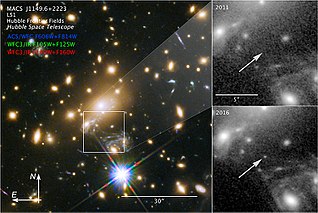Related Research Articles

A quasar is an extremely luminous active galactic nucleus (AGN). It is sometimes known as a quasi-stellar object, abbreviated QSO. The emission from an AGN is powered by a supermassive black hole with a mass ranging from millions to tens of billions of solar masses, surrounded by a gaseous accretion disc. Gas in the disc falling towards the black hole heats up and releases energy in the form of electromagnetic radiation. The radiant energy of quasars is enormous; the most powerful quasars have luminosities thousands of times greater than that of a galaxy such as the Milky Way. Quasars are usually categorized as a subclass of the more general category of AGN. The redshifts of quasars are of cosmological origin.

In physics, a redshift is an increase in the wavelength, and corresponding decrease in the frequency and photon energy, of electromagnetic radiation. The opposite change, a decrease in wavelength and simultaneous increase in frequency and energy, is known as a negative redshift, or blueshift. The terms derive from the colours red and blue which form the extremes of the visible light spectrum. The main causes of electromagnetic redshift in astronomy and cosmology are the relative motions of radiation sources, which give rise to the relativistic Doppler effect), and gravitational potentials, which gravitationally redshift escaping radiation. All sufficiently distant light sources show cosmological redshift corresponding to recession speeds proportional to their distances from Earth, a fact known as Hubble's law that implies the universe is expanding.

Astronomy is a natural science that studies celestial objects and phenomena. It uses mathematics, physics, and chemistry in order to explain their origin and evolution. Objects of interest include planets, moons, stars, nebulae, galaxies, meteoroid, asteroid, and comets. Relevant phenomena include supernova explosions, gamma ray bursts, quasars, blazars, pulsars, and cosmic microwave background radiation. More generally, astronomy studies everything that originates beyond Earth's atmosphere. Cosmology is a branch of astronomy that studies the universe as a whole.
This timeline of cosmological theories and discoveries is a chronological record of the development of humanity's understanding of the cosmos over the last two-plus millennia. Modern cosmological ideas follow the development of the scientific discipline of physical cosmology.

Sandra Moore Faber is an American astrophysicist known for her research on the evolution of galaxies. She is the University Professor of Astronomy and Astrophysics at the University of California, Santa Cruz, and works at the Lick Observatory. She has made discoveries linking the brightness of galaxies to the speed of stars within them and was the co-discoverer of the Faber–Jackson relation. Faber was also instrumental in designing the Keck telescopes in Hawaii.

A supermassive black hole is the largest type of black hole, with its mass being on the order of hundreds of thousands, or millions to billions of times the mass of the Sun (M☉). Black holes are a class of astronomical objects that have undergone gravitational collapse, leaving behind spheroidal regions of space from which nothing can escape, not even light. Observational evidence indicates that almost every large galaxy has a supermassive black hole at its center. For example, the Milky Way galaxy has a supermassive black hole at its center, corresponding to the radio source Sagittarius A*. Accretion of interstellar gas onto supermassive black holes is the process responsible for powering active galactic nuclei (AGNs) and quasars.

The Hubble Deep Field (HDF) is an image of a small region in the constellation Ursa Major, constructed from a series of observations by the Hubble Space Telescope. It covers an area about 2.6 arcminutes on a side, about one 24-millionth of the whole sky, which is equivalent in angular size to a tennis ball at a distance of 100 metres. The image was assembled from 342 separate exposures taken with the Space Telescope's Wide Field and Planetary Camera 2 over ten consecutive days between December 18 and 28, 1995.

Halton Christian "Chip" Arp was an American astronomer. He was known for his 1966 Atlas of Peculiar Galaxies, which catalogues many examples of interacting and merging galaxies, though Arp disputed the idea, claiming apparent associations were prime examples of ejections. Arp published Seeing Red: Redshift, Cosmology and Academic Science in 1998. Arp was also known as a critic of the Big Bang theory and for advocating a non-standard cosmology incorporating intrinsic redshift.
Observational cosmology is the study of the structure, the evolution and the origin of the universe through observation, using instruments such as telescopes and cosmic ray detectors.
The Sloan Digital Sky Survey or SDSS is a major multi-spectral imaging and spectroscopic redshift survey using a dedicated 2.5-m wide-angle optical telescope at Apache Point Observatory in New Mexico, United States. The project began in 2000 and was named after the Alfred P. Sloan Foundation, which contributed significant funding.

The following outline is provided as an overview of and topical guide to astronomy:
Astronomy Now is a monthly British magazine on astronomy and space. According to the Royal Astronomical Society, Astronomy Now is the "principal amateur astronomy magazine in Britain" with a reputed circulation of 24,000.
Tod R. Lauer is an American astronomer on the research staff of the National Optical Astronomy Observatory. He was a member of the Hubble Space Telescope Wide Field and Planetary Camera team, and is a founding member of the Nuker Team. His research interests includes observational searches for massive black holes in the centers of galaxies, the structure of elliptical galaxies, stellar populations, large-scale structure of the universe, and astronomical image processing. He was the Principal Investigator of the Destiny JDEM concept study, one of the precursors to the Nancy Grace Roman Space Telescope mission. Asteroid 3135 Lauer is named for him. He appears in an episode of the documentary series Naked Science. He joined the New Horizons Pluto team in order to apply his extensive experience with deep space imaging to the New Horizons data, yielding significantly clearer and mathematically accurate images of Pluto and Charon.

Wendy Laurel Freedman is a Canadian-American astronomer, best known for her measurement of the Hubble constant, and as director of the Carnegie Observatories in Pasadena, California, and Las Campanas, Chile. She is now the John & Marion Sullivan University Professor of Astronomy and Astrophysics at the University of Chicago. Her principal research interests are in observational cosmology, focusing on measuring both the current and past expansion rates of the universe, and on characterizing the nature of dark energy.

Jerome "Jerry" Kristian was a theoretical and observational cosmologist, and the first to provide observational evidence of quasar host galaxies.

ULAS J1342+0928 is the second-most distant known quasar detected and contains the second-most distant and oldest known supermassive black hole, at a reported redshift of z = 7.54. The ULAS J1342+0928 quasar is located in the Boötes constellation. The related supermassive black hole is reported to be "800 million times the mass of the Sun".

MACS J1149 Lensed Star 1, also known as Icarus, is a blue supergiant star observed through a gravitational lens. It is the second most distant individual star to have been detected so far, at approximately 14 billion light-years from Earth. Light from the star was emitted 4.4 billion years after the Big Bang. According to co-discoverer Patrick Kelly, the star is at least a hundred times more distant than the next-farthest non-supernova star observed, SDSS J1229+1122, and is the first magnified individual star seen.

Fabio Pacucci is an Italian theoretical astrophysicist and science educator, currently at Harvard University and at the Smithsonian Astrophysical Observatory. He is widely known for his contributions to the study of black holes, in particular the first population of black holes formed in the Universe and high redshift quasars. He discovered the only two candidate direct collapse black holes known so far, and he was in the team that discovered the farthest lensed quasar known. Pacucci is also a science educator, engaged in public talks on astronomy and science in general. Since 2018 he is a collaborator of TED in developing educational videos about science. The four videos released so far were watched by millions of people worldwide and translated into 25 languages.
References
- 1 2 "Rudy's Personal Statement".
- 1 2 "Nasa/Ads".
- ↑ Erickson, Jim (28 March 1991). "Tracking the age of the universe". Arizona Daily Star . Retrieved 2 September 2023– via Newspapers.com.
- ↑ Holden, Constance (8 November 1996). "Firming up a hubble constant". Science . ProQuest 213560484 . Retrieved 2 September 2023– via ProQuest.
- ↑ Reddy, Francis (October 2005). "The Double Quasar". Astronomy . Retrieved 2 September 2023– via ProQuest.
- ↑ "Hubble telescope findings indicate possibility of rogue planets". Washington Post . 21 April 1996. Retrieved 2 September 2023– via Newspapers.com.
- ↑ Catalano, Peter (December 1997). "On the trail of rogue planets". Astronomy . Retrieved 2 September 2023– via ProQuest.
- ↑ Chown, Marcus (2 March 2005). "Strung up". The Independent . Retrieved 2 September 2023– via Newspapers.com.
- ↑ Knapton, Sarah (6 March 2023). "Fossil samples may be evidence of life on Mars". The Leader-Post . Retrieved 2 September 2023– via Newspapers.com.
- ↑ R.E. Schild; D.J. Leiter; S.L. Robertson (2006). "Observations Supporting the Existence of an Intrinsic Magnetic Moment inside the Central Compact Object within the Quasar Q0957+56". The Astronomical Journal . 132 (1): 420–432. arXiv: astro-ph/0505518 . Bibcode:2006AJ....132..420S. doi:10.1086/504898. S2CID 119355221.
- ↑ I. Sample (30 July 2006). "US team's quasar probe sinks black hole theory". The Age . Retrieved 2 September 2023.
- ↑ Journal of Cosmology